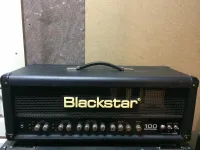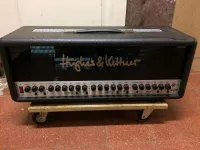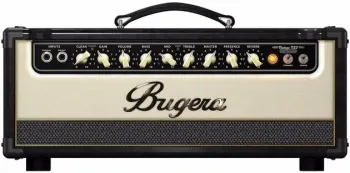Eladó egy keveset használt, megkímélt állapotú Fender ProSonic 210 60 wattos fullcsöves Custom Shop gitárkombó.
Klasszikus fullcsöves gitárkombó 2x10˝-os hangszóróval, Bruce Zinky által tervezve. Fender Custom Shop termék. 1996-tól 2002-ig gyártották. Made In USA.
Csere, beszámítás nem érdekel. Budapesten kipróbálható.
Adatok:
60 Watt
2-10˝ Custom Design Celestion® speakers
2 channels
2 x 5881 Power Tubes
5 x 12AX7 Preamp Tube
1 x 12AT7 Preamp Tube
1 x 5AR4 Rectifier Tube
switchable recifier / bias:
• solid state rectifier, class A/B 60w
• tube rectifier, class A/B 50w
• tube rectifier, class A 30w
effects send & return
birch/maple plywood cabinet
ca. 22 kg
The Prosonic introduced several features that had previously been seldom, or never before, seen in Fender amplifiers. Its most unusual feature is the switchable rectifier and power amplifier bias scheme, allowing on-the-fly changes of operating mode and output power (as well as subjective tonal differences). This feature, originally found on Randall Smith`s Mesa Boogie amplifiers, allows the Prosonic to achieve a versatility very rarely seen from mass-market instrument manufacturers. The Prosonic`s rear-mounted RECTIFIER/BIAS switch lets the user select from the following three options:
Solid-state rectification with fixed bias (marked ˝S.S. AB2˝). Listed at 60 Watts R.M.S.
Tube rectification with fixed bias (marked ˝AB2˝). Listed at 50 Watts R.M.S.
Tube rectification with cathode bias (marked ˝A˝). Listed at 30 Watts R.M.S.
Unlike many amplifiers marketed as ˝Class A˝, the Prosonic truly functions as a Class A power amplifier in the ˝A˝ position. Class A refers to the amount of current flowing through the power tubes with zero audio signal, with Class A meaning maximum current flow even with zero signal. This makes the tubes run hotter, and gives the power section even more gain at the cost of tube life and noise. The Class-A designation for guitar amplifiers is often a misnomer; Few amps outside of the heralded Vox AC-30, also with cathode bias, operate in a true Class-A mode [Albeit, it only did so up to ~21 watts RMS]. While the Prosonic featured cathode bias in the Class A mode and fixed bias in the Class AB mode, not all class A tube amplifiers are cathode-biased, and not all fixed biased amplifiers are Class AB. Fixed bias amps, however, require lower B+ Voltages to stay within the Plate Dissipation of the power tubes used; Cathode biasing ˝throws away˝ this voltage using conventional Higher Voltage power supplies.
A channel-switching amp, the Prosonic offers a clean channel that features a blend of traditional Fender sounds with the influence of Vox amplifiers, frequently attributed to the Class A mode. Many players praise the Prosonic`s clean channel as being ˝softer,˝ and more prone to break-up and musically desirable distortion, than more contemporary Fender designs. Detractors view this trait as an apparent ˝darkness˝ in tone, and perceive this lack of the typical Fender ˝sparkle˝ as merely an undesirable lack of clean headroom.
The Prosonic also brought levels of gain (distortion) previously unavailable in a Fender amplifier. Taking a major cue from the first generation of Mesa Boogie amplifiers such as the Mark I (itself a modified Fender design), the Prosonic used additional gain stages in the preamp section that cascaded into one another. Although Fender had been designing amps with some facility for built-in distortion/overdrive since at least the late 1960s, never before had they arrived at a sound so readily usable for modern high-gain styles of music, and far removed from what many players consider to be archetypical Fender tones. The Prosonic`s factory manual states, ˝Gain 1 functions as a standard gain stage whereas Gain 2 functions similar to a compressor, adding sustain while reducing `edge` when the volume is increased. This channel produces great high gain sound at any volume - from bedroom to stadium.˝
An all-tube design, the Prosonic uses standard 12AX7A tubes in the preamp sections, and one for the reverb send on the combo model. Output tubes are 5881/6L6WGCs. The rectifier tube is a 5AR4 (GZ34). The spring reverb unit in the combo model also uses a 12AT7 tube.
Although the Prosonic is a channel-switching amp, both channels share the same EQ section. Defying conventional logic, the Prosonic offers independent master volumes for each channel, or rather, on the clean channel, simply one volume control. The drive channel features the aforementioned dual cascading-gain controls, plus an additional master volume.
Two outputs for speaker cabinets are provided, (with switchable 4/8/16 ohm operation on the head version). The back panel also provides for a line-level effects loop, as well as an input for the channel-switching footswitch (the footswitch had a reverb button on combo models as well).
 read the test »
read the test »
Full points in the review: 7.8 ponits
You can read all the reviews from our members here »
Related ads
Blackstar Series One 100 wattos fullcsöves gitárerősítő fej
 Eladó egy hibátlan műszaki és szép esztétikai állapotú [...]
190.000,00 HUF
Eladó egy hibátlan műszaki és szép esztétikai állapotú [...]
190.000,00 HUF
Line6 DT50 HD 50W fullcsöves modellezős gitárerősítő fej
 Eladó egy hibátlan műszaki és szép esztétikai állapotú [...]
195.000,00 HUF
Eladó egy hibátlan műszaki és szép esztétikai állapotú [...]
195.000,00 HUF
Blackstar Series One 100 wattos fullcsöves gitárerősítő fej
 Eladó egy hibátlan műszaki és esztétikai állapotú Blackstar [...]
200.000,00 HUF
Eladó egy hibátlan műszaki és esztétikai állapotú Blackstar [...]
200.000,00 HUF
Hughes&Kettner Triamp 100W fullcsöves, 6 csatis gitárerősítő fej
 Eladó egy hibátlan műszaki állapotú Hughes and Kettner [...]
230.000,00 HUF
Eladó egy hibátlan műszaki állapotú Hughes and Kettner [...]
230.000,00 HUF
 Deutsch
Deutsch English
English Español
Español Magyar
Magyar Slovenský
Slovenský

